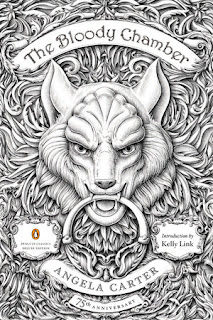My themed-read Science Fiction and Fantasy book club is in the midst of a theme on Fairy Tales, and although I'd never read The Bloody Chamber, I knew I had to get Angela Carter in there somewhere. All I've read of her before is Wise Children, so, with the help of google, I picked this set of short stories for her inclusion in the theme, crossed my fingers, and hoped.
We had the club meeting last night, at the time of writing this, and overall, I think it ended up being a good pick. There were some questions about the order of the stories and some of the stories within, and it sparked some good conversations, although I forgot to try to link it to the previous book so we can build on what we've talked about each month as we go. Ah well, next month.
For a retelling of fairy tales, this is long on sexuality, budding bodies, potential sexual violence, and self-discovery. That's not particularly unexpected, as these are often the subtext of fairy tales, brought into text forcefully. There are a number of stories that mash together a couple of fairy tales to create something unsettling, like the story where Little Red Riding Hood meets a classic werewolf folk tale.
It is odd that the stories are grouped so that every run she makes at a particular fairy tale comes one right after the other. There are back-to-back Beauty and the Beast stories, and three or four Little Red Riding Hood/werewolf stories, one right after the other. This felt a little odd, more like you were reading someone's drafts that truly different stories, even though each was a distinct take.
I don't know if any of us knew quite what to make of the Erl-King story, other than what it was on its face, a story of sexual obsession and submission.
While these are stories that come from a feminist root, they're not so much stories of female empowerment. Some of them are stories of male violence, and in others, while the women end up in better positions than they started, it tends to be less because of actions they themselves have taken as because those around them have supported them in becoming who they would like to be. There are a bunch of stories of women with animal or part-animal lovers that allow them to indulge and discover their sexuality without restraint. But these are not stories of women actively changing their own destinies, for the most part. The opportunity to embrace a new destiny comes to them, mostly unsought, and they seize it.
Animality and humanity are common themes, with animals or half-human animals often being portrayed as more honest (although not all - that one werewolf!) than humans. "Wolf-Alice," the last story, is probably the most explicit exploration of this, with the feral girl learning gradually how to think in the future and past, sadly distancing herself from who she was when she was raised by wolves. But it's there in the Beauty and the Beast stories as well.
Then there's the one Dracula meets Sleeping Beauty meets The Boy Who Couldn't Shudder story, where a lonely vampire lady lives in her crumbling Bulgarian castle, draining those who stop by unwittingly, until a young blond male virgin soldier comes by. At my book club meeting, we had different opinions of what the ending meant, with my husband coming up with a far creepier interpretation than the rest of us. I'm not sure he's wrong, and shudder.
Reading this book often left me unsure what I wanted to say about it, and I find that continues. There's a lot here, but there doesn't feel like one big cohesive point. This is not unexpected, given that it is made up of short stories. There are a lot of little points to consider, and I feel like I've barely scratched the surface.

No comments:
Post a Comment